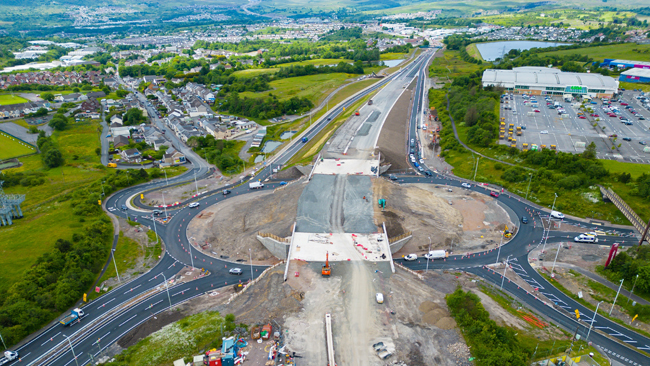
Welsh infrastructure Failures: A 20-Year Review
Welsh infrastructure Failures: Infrastructure development plays a critical role in economic growth, community connectivity, and overall quality of life. However, in Wales, the past 20 years have seen a number of high-profile infrastructure projects plagued by delays, cost overruns, and underwhelming results. The failure of these projects has drawn significant criticism and raised questions about the planning and execution capabilities of the Welsh Government. This article explores some of the key examples and underlying issues contributing to these failures.
Case Studies of Infrastructure Failures
1. The M4 Relief Road Debacle
The M4 relief road, intended to alleviate chronic congestion around Newport, is perhaps the most infamous example of a failed infrastructure project in Wales. First proposed in the 1990s, the project suffered from years of political indecision, environmental opposition, and escalating costs. By 2019, after decades of debate and over £114 million spent on planning and consultations, the project was scrapped by First Minister Mark Drakeford, citing environmental concerns and budgetary constraints. The decision left many questioning the lack of foresight and wasted public funds.
2. The South Wales Metro Delays
The South Wales Metro, envisioned as a transformative public transport system for the Cardiff Capital Region, has also faced significant challenges. Originally slated for completion by 2023, the project has been delayed due to funding gaps, logistical complexities, and the impact of the COVID-19 pandemic. While progress has been made, with some new trains and upgraded stations introduced, the overall project remains behind schedule and over budget, frustrating commuters and local businesses.
3. The A465 Heads of the Valleys Road
The A465 Heads of the Valleys road project, aimed at improving a critical transport link in South Wales, has been another example of spiralling costs and delays. Initially budgeted at £428 million, the project’s cost has ballooned to over £900 million, with completion dates repeatedly pushed back. The complexities of the terrain, alongside unforeseen engineering challenges, have contributed to the escalating costs. The project’s delays and budget overruns have frustrated local residents and businesses, who continue to endure significant traffic disruption.
 . Housing and Regeneration Projects
. Housing and Regeneration Projects
Several housing and regeneration schemes in Wales have failed to deliver on their promises. For example, the Circuit of Wales project, a proposed motorsport track near Ebbw Vale, was touted as a catalyst for economic regeneration in the area. However, after years of planning and over £9 million spent on feasibility studies, the project was abandoned in 2017 due to funding shortfalls and concerns over its economic viability. This left local communities disappointed and sceptical of future government promises.
5. Circuit for Wales
Underlying Issues Behind the Failures
1. Poor Planning and Feasibility Studies
One recurring theme in these failures is inadequate planning and unrealistic feasibility studies. Projects often proceed without a clear understanding of potential risks, environmental impacts, and financial requirements, leading to costly delays and cancellations.
2. Political Interference and Short-Term Thinking
Political considerations frequently overshadow long-term strategic planning. Changes in leadership and shifting priorities disrupt the continuity of projects, as seen in the M4 relief road and other initiatives. The tendency to prioritise short-term political gains over sustainable development has undermined trust in government-led infrastructure efforts.
3. Environmental Concerns and Public Opposition
Wales’ commitment to environmental sustainability has, in some cases, contributed to project failures. While these concerns are valid, the lack of a balanced approach that integrates environmental goals with economic development has hindered progress. Public opposition to projects perceived as environmentally damaging has also delayed or derailed key initiatives.
4. Funding Challenges
A reliance on external funding, coupled with limited budgets, has left many projects vulnerable to financial shortfalls. The Circuit of Wales and South Wales Metro are prime examples of ambitious projects that faltered due to insufficient funding and an overreliance on speculative economic benefits.
The Impact on Wales
The failure of major infrastructure projects has had a tangible impact on Wales. Chronic traffic congestion, inadequate public transport, and missed opportunities for economic regeneration have all contributed to a sense of stagnation in many communities. Moreover, the repeated cycle of failed projects has eroded public trust in the Welsh Government’s ability to deliver on its promises.
Lessons for the Future
To avoid repeating past mistakes, the Welsh Government must adopt a more strategic and transparent approach to infrastructure development. Key recommendations include:
- Enhanced Planning and Risk Assessment: Conduct thorough feasibility studies and risk assessments before committing to projects.
- Long-Term Vision: Develop and adhere to long-term infrastructure plans that transcend political cycles.
- Public Engagement: Actively involve local communities and stakeholders in the planning process to build consensus and mitigate opposition.
- Sustainable Development: Integrate environmental considerations with economic goals to create balanced and achievable projects.
- Securing Funding: Establish robust funding strategies that reduce reliance on speculative projections and ensure financial sustainability.
Conclusion
The Welsh Government’s track record on infrastructure projects over the past 20 years highlights systemic issues that must be addressed to ensure future success. By learning from past failures and implementing more strategic, sustainable, and transparent practices, Wales can unlock its potential and deliver infrastructure that truly benefits its people and economy.












